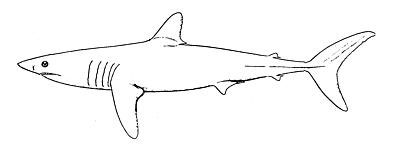|

Weights and Measures: With a full-grown length of 9 - 13 ft (2.75 - 4 m), the shortfin mako has been reported to weigh up to 1,750 pounds (800 kg), and has a bluish back and white underside. Although the sexes grow at about the same rate, females are thought to have a longer life span, grow larger and weigh more than the males.
Just the Facts: The longfin mako's full-grown length is over 4 metres, and it has a dark bluish back and white underside. The pectoral fins are about as long as the head or longer, relatively broad-tipped in young and adults. The snout is usually narrowly to bluntly pointed, usually not acute. The cusps of upper and lower anterior teeth are straight, with tips not reversed. The caudal fin is lunate, with a very long lower lobe.


Where in the World? The shortfin mako is found in temperate and tropical seas worldwide. Some of the largest makos in the world can be found in New England waters. The closely related longfin mako shark, Isurus paucus, is found in the Gulf Stream or warmer offshore waters.
Shark Olympians: The shortfin and longfin mako's speeds have been recorded at over 22 miles (35 kilometres) per hour. Shortfin makos can jump up to 20 feet in the air. Due to its speed and agility, this high leaping fish is sought as game worldwide.

Birds and Bees: The shortfin mako shark is a yolk-sac ovoviviparous shark, meaning it gives birth to live young who feed from a sac full of yolk in the womb. The gestation period for a mako shark is 15 - 18 months. Shortfin mako embryos in the female's body actually consume each other to get nutrients. This is called intrauterine cannibalism.

What's in a Name? The name "mako" comes from the Ma-ori language for blue lightning, reflecting its colour and speed.
All text is available under the terms
of the GNU Free Documentation License
|